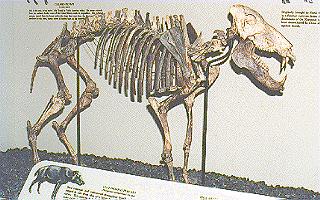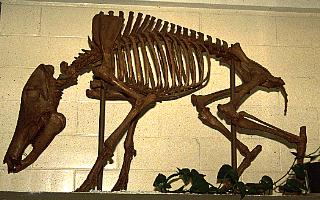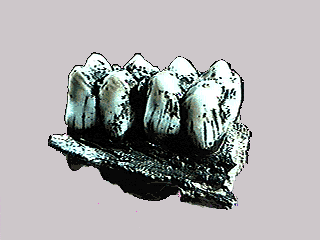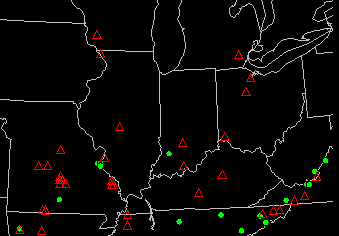Peccaries

Flat-headed Peccary skeleton from Welsh Cave, Kentucky
Peccaries are members of the artiodactyl family Tayassuidae.
They are New World relatives of the Old World true pigs (family
Suidae). Peccaries can easily be distinguished by the fact that
their upper canines (tusks) point downward. In true pigs (suids)
the tusks curve upward. In addition, peccaries have less complex
cheek teeth, reduced side toes, and large, dorsal musk glands.

Long-nosed Peccary skeleton from Friesenhahn Cave, Texas
Two species of peccary were present in North America north of
Mexico 16,000 years ago, and remains of both are found in the midwestern U.S.
The two species are the flat-headed peccary (Platygonus
compressus) and the long-nosed peccary (Mylohyus
nasutus).
Both the flat-headed peccary and the long-nosed-peccary stood
about three-quarters of a meter (about 30 inches) tall at the
shoulder and probably weighed around 50 kg (110 pounds). Both were
probably fairly omnivorous, although the long-nosed peccary
consumed more browse (trees and shrubs) than did the flat-headed
peccary.
The flat-headed peccary apparently lived in herds. Sometimes
these herds used caves as shelters. Large numbers of peccary bones
have been found in several caves in Kentucky, Missouri, and Texas.
In some cases, such as Welsh Cave, Kentucky (specimen shown above),
Bat Cave, Missouri, Zoo Cave, Missouri, and Laubach Cave, Texas,
these finds probably represent long-term usage of a cave by herds
of peccaries. Unlike the flat-headed peccary, Mylohyus was
probably a solitary animal and did not frequent caves. In spite of
the fact that they did not frequent caves, occasionally long-nosed
peccary remains are found in caves.

 To the left is
a fragment of a long-nosed peccary jaw was recovered from a
cave in Jefferson County, Missouri. The teeth are shorter and have more
rounded cusps than do the teeth of the
flat-headed peccary (on the right). These differences in the teeth are due to
the fact that long-nosed peccaries lived in woodlands and ate
mainly shrubs while flat-headed peccaries lived in open areas and
ate coarser vegetation.
To the left is
a fragment of a long-nosed peccary jaw was recovered from a
cave in Jefferson County, Missouri. The teeth are shorter and have more
rounded cusps than do the teeth of the
flat-headed peccary (on the right). These differences in the teeth are due to
the fact that long-nosed peccaries lived in woodlands and ate
mainly shrubs while flat-headed peccaries lived in open areas and
ate coarser vegetation.
Bat Cave, Missouri contained the remains of at least 98
individual flat-headed peccaries. The material from this site
is in the collections of the Illinois State Museum.
You can also view a
QTVR object movie of
the jaw fragment.
Both Platygonus and Mylohyus became extinct in
North America approximately 11,500 years ago. The reason for their
extinction is being studied by paleontologists.
Peccary Finds in the Midwestern U.S.

This map shows some of the sites at which the flat-headed peccary
(red triangles) and long-nosed peccary (green dots) have been found
in the midwestern United States. The sites on this map are all
relatively well-dated and well-studied. These sites contain peccary
remains that are between 40,000 and 11,500 years old.
Peccaries have a long fossil history. They first evolved around
33 million years ago in either North America or Eurasia. They are
present in North America from that time right through to the
present. Between about 5 and 33 million years ago they were also
found in the Old World. Peccaries dispersed into South America
approximately 2.5 million years ago and have been successful in
that area since. Three species of peccary are alive today. The
Chacoan peccary (Catagonus wagneri), which is found in the
Gran Chaco region of Bolivia, Paraguay and Argentina, is a close
relative of the extinct Platygonus. The collared peccary
(Tayassu tajacu) ranges from Arizona and Texas south to
northern Argentina. The white-lipped peccary (Tayassu
pecari) ranges from southern Mexico to northern Argentina.
 To the left is
a fragment of a long-nosed peccary jaw was recovered from a
cave in Jefferson County, Missouri. The teeth are shorter and have more
rounded cusps than do the teeth of the
flat-headed peccary (on the right). These differences in the teeth are due to
the fact that long-nosed peccaries lived in woodlands and ate
mainly shrubs while flat-headed peccaries lived in open areas and
ate coarser vegetation.
To the left is
a fragment of a long-nosed peccary jaw was recovered from a
cave in Jefferson County, Missouri. The teeth are shorter and have more
rounded cusps than do the teeth of the
flat-headed peccary (on the right). These differences in the teeth are due to
the fact that long-nosed peccaries lived in woodlands and ate
mainly shrubs while flat-headed peccaries lived in open areas and
ate coarser vegetation.


